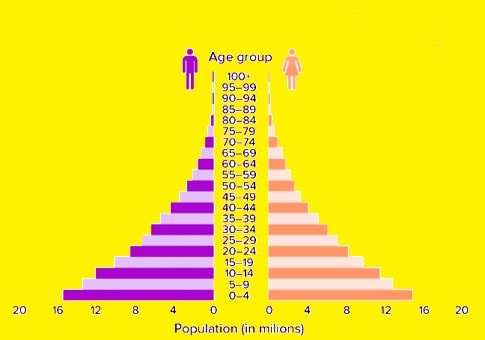The types of population pyramid are the different graphs that can be drawn in a demographic pyramid, based on the population structure of the territory in terms of the variables of sex and age.
A population pyramid is a graphic representation that shows the characteristics of a population of a town, city, or country at a specific time.
Population pyramid: Simple explanation
The pyramid has a vertical axis that shows the different age ranges of a population. Five-year age ranges are generally used (for example, 0 to 4 years, 5 to 9 years, 10 to 14 years, and so on). The horizontal axis measures the volume of people in each age range. This volume is shown by horizontal bars whose length is proportional to the number of individuals in that range.
Therefore, depending on the population structure of a territory, the graph will show one type of pyramid or another. In places with a lot of young people, we see a traditional pyramid, while in areas with a larger adult population, an inverted pyramid appears.
There are several types of pyramids established by experts, which offer us information about the population according to the shape of the pyramid.
Let’s look at the types of population pyramids!
Types of population pyramid
Among the existing types of population pyramid, we could highlight the 4 main types: progressive population pyramid, stationary or stagnant pyramid, regressive pyramid, and unbalanced pyramid.
Progressive population pyramid
The progressive population pyramid is the population pyramid that characterizes underdeveloped and developing economies. The population tends to have many children, so a large percentage of the population is usually concentrated at the lower end of the distribution. In turn, due to lower life expectancy, as we move up the age ranges, these present a lower population density.
The drawing, therefore, shows us a wide base and a thinner top.
Example of a progressive population pyramid
The population of Guinea, for example, is characterized by presenting this type of pyramid, as we can see below:

Regressive population pyramid
The regressive population pyramid is exactly the opposite of the progressive population pyramid, as indicated by the figure it draws and its name itself.
We are thus talking about the type of pyramid that characterises rich countries, which have, as we know very well, a very low birth rate in contrast to that of developing and underdeveloped countries. Similarly, as they have a very high life expectancy, the high part of the distribution, where the oldest population is concentrated, has a high population density.
Therefore, the drawing that we see in this type of pyramid is the opposite of the previous one. The bases are usually thin and the upper parts, or what we call the peaks, are usually thick since they have few young people and a lot of adult and elderly people.
This type of pyramid is also known as an inverted pyramid.
Stagnant or stationary population pyramid
The stationary population pyramid, or stagnant population pyramid, is the one that characterizes developing countries. Therefore, a balance in distribution can be observed, as a consequence of the fact that mortality has begun to be controlled, but the birth rate remains quite high.
This type of population pyramid has a birth and death rate that generally does not vary significantly over a long period of time. Some experts consider this pyramid to be the intermediate step between a progressive pyramid and a regressive pyramid.
Therefore, the drawing that we see in this type of pyramid is that of a base and structure similar throughout the entire pyramid, which is progressively reduced from a certain age range.
Unbalanced or misaligned population pyramid
It is the type of pyramid that characterizes countries in which an event has occurred that has altered the demographic structure, generating significant disproportions such as those we will see below.
Thus, we are talking about a type of pyramid that we can see in countries that have participated in a war and have suffered the loss of a large part of the male population. Also in countries that have suffered waves of migration, where children and women have had to leave the country en masse due to some specific event. In general, countries that have been affected by some notable event, leaving the population disproportionately large.
Therefore, the pattern observed in this type of pyramid does not follow any pattern. It is characterized by being irregular and presenting random shapes, that do not correspond to the other side of the pyramid, and vice versa.
Key points
- The expanding pyramid indicates a high birth and death rate.
- The stationary pyramid shows a balance in the birth and death rates.
- The regressive pyramid reflects a low birth rate and a high life expectancy.

